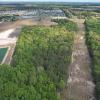A study of chemicals found in the Inland Bays near Burton Island, the site of a now closed coal-ash dump, showed elevated levels of selenium in samples taken near the island.
The study, a collaborative effort from the Center for the Inland Bays and the Smithsonian Institution, is expected to be released in June. It was not completed in time for consideration during the Delaware Department of Natural Resources and Environmental Control hearings on remediation plans for Burton Island.
According to the draft study, "Since selenium is an element widely associated with the fly ash from power plants, it is tempting to think of this as a likely result of the leachate from the ash piles near Island Creek into the creek waters, either via surface run off, subsurface transport, or the slumping of ash material into the creek."
The study continues, "While entirely possible, the data do not provide direct evidence of this, and further work would be necessary to prove that the excess selenium in organisms found in Island Creek originates from the Burton’s Island ash disposal area.”
In preliminary discussions of the study during a meeting of the Citizens Advisory Committee of the Center for the Inland Bays, center executive director Chris Bason said levels of selenium in organisms near the landfill were higher than those in the control site on Pepper Creek.
Bason said the study focused on toxins found in bay creatures, but at this point the study does not address where the toxins originated.
"The effect, if any, that this may have on the organisms needs to be evaluated. And it’s important to point out that the study is still under review," he said.
In a few cases, elevated levels of arsenic were also found.
John Austin, liaison with the CIB's Citizen's Advisory Committee and Scientific and Technical Advisory Committee, said he believes higher levels of arsenic in the bays are tied to leaching from Burton Island.
Austin said more information will be known when the study is released.
A 2008 study of 1,600 samples taken in the Inland Bays from 1998 to 2008 found no elevated levels of arsenic. At the time, only 1 percent of samples contained levels of arsenic higher than allowed for human consumption.
State officials, environmentalists and committee members will review the findings before the results are released.
NRG spokesman David Gaier, who did not attend the meeting, said coal ash from the plant was first deposited on Burton Island in 1957 when Delmarva Power & Light operated the plant. The dump was closed in 1979 when a new, state-of-the-art landfill was built at the Indian River facility. Gaier said his review of the study he does not believe elevated selenium is related to coal ash on Burton Island.
NRG inherited the dumpsite and is working with DNREC to clean it up. DNREC held a public hearing in Millsboro Feb. 6 to discuss plans, which include covering about two acres of open land to reduce spread of the toxic ash.
Gaier said there is no estimate of how much coal ash was deposited on Burton Island, but he said vegetation, trees and bushes have been allowed to grow over the entire surface of the island, providing a protective cover.
Gaier said NRG is working with DNREC on a voluntary cleanup plan to place an additional protective soil cover on specific areas of the island and to continue monitoring efforts.
The plan is in the final stage and is awaiting DNREC Secretary Collin O'Mara's signature, Gaier said.
DNREC spokesman Michael Globetti said, “DNREC has no comment at this time on the proposed plan of remediation, nor comment on the CIB report until it is finalized. That report is currently under peer review, including DNREC representatives submitting comment on the draft report.”
Gaier said a $6.3 million two-year project, completed in 2011, installed riprap around the island to reduce leaching and prevent erosion.
“The project showed its durability during both hurricanes Sandy and Irene and during the November 2009 nor'easter,” Gaier said. “It performed as intended with no erosion or damage.”
Gaier said he respects the work done by the CIB, but he said it is not related to any required regulatory or legal process. He said NRG is working with DNREC to comply with environmental regulations.
Problems with aquatic selenium
A study published in January by researchers at Marshall University in West Virginia found elevated levels of selenium posed a toxic threat to aquatic organisms. A similar 2009 study published by researchers at the University of Saskatchewan found selenium in rainbow trout caused toxicity and cell death in high concentrations. Selenium can also affect the DNA of aquatic life, researchers found.
"Selenium is an essential micronutrient to freshwater fish, but can be very toxic at slightly above the threshold level," writes the University of Saskatchewan researchers. "The liver is known to be the major site of selenium accumulation and metabolism in fish."
Elevated levels of selenium can cause problems for fish, report the Marshall University researchers.
"Chronic exposure (mainly dietary) of mature female fish to selenium has the potential to cause developmental abnormalities in developing embryos due to the maternal transfer of selenium into the eggs," states the report.
In West Virginia, mining-related selenium discharges caused concern for the researchers, who focused on the Mud River watershed where selenium concentrations were the highest.























































